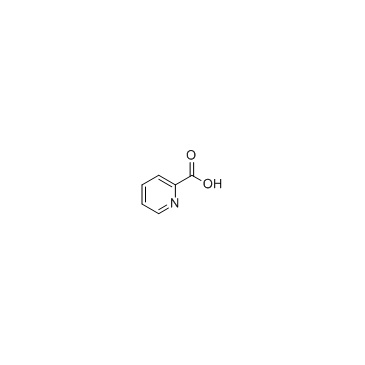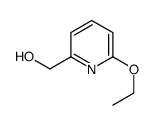6-Oxo-1,6-dihydropyridine-2-carboxylic acid

6-Oxo-1,6-dihydropyridine-2-carboxylic acid structure
|
Common Name | 6-Oxo-1,6-dihydropyridine-2-carboxylic acid | ||
|---|---|---|---|---|
| CAS Number | 19621-92-2 | Molecular Weight | 139.109 | |
| Density | 1.5±0.1 g/cm3 | Boiling Point | 493.0±30.0 °C at 760 mmHg | |
| Molecular Formula | C6H5NO3 | Melting Point | 270 °C (dec.)(lit.) | |
| MSDS | Chinese USA | Flash Point | 251.9±24.6 °C | |
| Symbol |

GHS07 |
Signal Word | Warning | |
| Name | 6-oxo-1H-pyridine-2-carboxylic acid |
|---|---|
| Synonym | More Synonyms |
| Density | 1.5±0.1 g/cm3 |
|---|---|
| Boiling Point | 493.0±30.0 °C at 760 mmHg |
| Melting Point | 270 °C (dec.)(lit.) |
| Molecular Formula | C6H5NO3 |
| Molecular Weight | 139.109 |
| Flash Point | 251.9±24.6 °C |
| Exact Mass | 139.026947 |
| PSA | 70.42000 |
| LogP | -1.13 |
| Vapour Pressure | 0.0±1.3 mmHg at 25°C |
| Index of Refraction | 1.626 |
| InChIKey | VRCWSYYXUCKEED-UHFFFAOYSA-N |
| SMILES | O=C(O)c1cccc(=O)[nH]1 |
| Symbol |

GHS07 |
|---|---|
| Signal Word | Warning |
| Hazard Statements | H315-H319-H335 |
| Precautionary Statements | P261-P305 + P351 + P338 |
| Personal Protective Equipment | dust mask type N95 (US);Eyeshields;Gloves |
| Hazard Codes | Xi:Irritant; |
| Risk Phrases | R36/37/38 |
| Safety Phrases | S26-S36 |
| RIDADR | NONH for all modes of transport |
| WGK Germany | 3 |
| HS Code | 2933399090 |
|
~51% 
6-Oxo-1,6-dihyd... CAS#:19621-92-2 |
| Literature: Puy, Michael Van Der; Nalewajek, David; Wicks, Gene E. Tetrahedron Letters, 1988 , vol. 29, # 35 p. 4389 - 4392 |
|
~% 
6-Oxo-1,6-dihyd... CAS#:19621-92-2 |
| Literature: Journal of Organic Chemistry, , vol. 6, p. 566,573 |
|
~% 
6-Oxo-1,6-dihyd... CAS#:19621-92-2 |
| Literature: Acta Crystallographica Section C: Crystal Structure Communications, , vol. 60, # 7 p. m338-m340 |
| Precursor 3 | |
|---|---|
| DownStream 10 | |
| HS Code | 2933399090 |
|---|---|
| Summary | 2933399090. other compounds containing an unfused pyridine ring (whether or not hydrogenated) in the structure. VAT:17.0%. Tax rebate rate:13.0%. . MFN tariff:6.5%. General tariff:20.0% |
|
Identifying chelators for metalloprotein inhibitors using a fragment-based approach.
J. Med. Chem. 54 , 591-602, (2011) Fragment-based lead design (FBLD) has been used to identify new metal-binding groups for metalloenzyme inhibitors. When screened at 1 mM, a chelator fragment library (CFL-1.1) of 96 compounds produced... |
|
|
Synthesis, molecular, spectroscopic and catalytic characterization of ruthenium (II) complexes with pyridine-2-carboxylic acid derivatives ligands. Malecki JG, et al.
Polyhedron 48(1) , 21-30, (2012)
|
|
|
Computational study of the intramolecular proton transfer between 6-hydroxypicolinic acid tautomeric forms and intermolecular hydrogen bonding in their dimers. Kazemi Riabi SH, et al.
Phys. Chem. Res. 1 , 117-125, (2013)
|
| 1,6-Dihydro-6-oxo-nicotinic acid |
| 6-hydroxypyridine-3-carboxylic acid |
| 2-Pyridinecarboxylicacid,1,6-dihydro-6-oxo |
| 6-Hydroxynicotinic acid |
| 2-Hydroxypyridine-6-carboxylic acid |
| 2-hydroxy-6-picolinic acid |
| 6-Hydroxyniacin |
| T6MVJ EVQ |
| 1,6-dihydro-6-oxopyridine-3-carboxylic acid |
| 3-Pyridinecarboxylic acid, 1,6-dihydro-6-oxo- |
| 6-carboxy-2-hydroxy-pyridine |
| 6-Hydroxypicolinic acid |
| 6-Hydroxypyridine-2-carboxylic acid |
| 6-hydroxopicolinic acid |
| 6-Oxo-1,6-dihydro-3-pyridinecarboxylic acid |
| 1,6-Dihydro-6-oxo-3-pyridinecarboxylic acid |
| 2-Pyridinecarboxylic acid, 6-hydroxy- |
| 6-oxo-1,6-dihydropyridine-2-carboxylic acid |
| T6NJ BQ EVQ |
| EINECS 225-682-9 |
| MFCD00192220 |
| 6-Hydroxy-2-pyridinecarboxylic Acid |
| EINECS 417-690-8 |
| 6-Oxo-1,6-dihydro-2-pyridinecarboxylic acid |



 CAS#:210366-15-7
CAS#:210366-15-7 CAS#:63071-12-5
CAS#:63071-12-5 CAS#:156094-63-2
CAS#:156094-63-2 CAS#:352514-21-7
CAS#:352514-21-7 CAS#:26256-72-4
CAS#:26256-72-4 CAS#:26893-73-2
CAS#:26893-73-2 CAS#:80099-98-5
CAS#:80099-98-5 CAS#:890655-74-0
CAS#:890655-74-0 CAS#:890655-75-1
CAS#:890655-75-1 CAS#:59864-31-2
CAS#:59864-31-2
